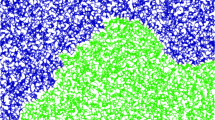Abstract
In the paper, we describe a polynomial time algorithm that, for every input graph, either outputs the minimum bisection of the graph or halts without output. More importantly, we show that the algorithm chooses the former course with high probability for many natural classes of graphs. In particular, for every fixedd≧3, all sufficiently largen and allb=o(n 1−1/[(d+1)/2]), the algorithm finds the minimum bisection for almost alld-regular labelled simple graphs with 2n nodes and bisection widthb. For example, the algorithm succeeds for almost all 5-regular graphs with 2n nodes and bisection widtho(n 2/3). The algorithm differs from other graph bisection heuristics (as well as from many heuristics for other NP-complete problems) in several respects. Most notably:
-
(i)
the algorithm provides exactly the minimum bisection for almost all input graphs with the specified form, instead of only an approximation of the minimum bisection,
-
(ii)
whenever the algorithm produces a bisection, it is guaranteed to be optimal (i.e., the algorithm also produces a proof that the bisection it outputs is an optimal bisection),
-
(iii)
the algorithm works well both theoretically and experimentally,
-
(iv)
the algorithm employs global methods such as network flow instead of local operations such as 2-changes, and
-
(v)
the algorithm works well for graphs with small bisections (as opposed to graphs with large bisections, for which arbitrary bisections are nearly optimal).
Similar content being viewed by others
References
B. Baker, Approximation Algorithms for NP-complete Problems on Planar Graphs,FOCS 1983, 265–273.
E. R. BARNES, An Algorithm for Partitioning the Nodes of a Graph,IBM Technical Report RC8690, 1981.
E. R. Barnes andA. J. Hoffman, Partitioning, Spectra and Linear Programming,IBM Research Report, (unknown date).
S. N. Bhatt andF. T. Leighton, A Framework for Solving VLSI Graph Layout Problems,Journal of Computer and System Sciences,28 (1984).
B. Bollobás, A Probabilistic Proof of an Asymptotic Formula for the Number of Labelled Regular Graphs,European J. Combinatorics,1 (1980), 311–316.
B. Bollobás andW. Fernandez de la Vega, The Diameter of Random Regular Graphs,Combinatorica,2 (1982), 125–134.
M. A. Breuer, Min-cut Placement,J. Design Aut. and Fault Tol. Comp.,1 (1977), 343–362.
W. E. Donath andA. J. Hoffman, Lower Bounds for the Partitioning of Graphs,IBM J. Res. Develop.,17 (1973), 420–425.
C. M. Fiduccia andR. M. Mattheyses, A Linear-Time Heuristic for Improving Network Partitions,Proceedings of the 19th Design Automation Conference, IEEE Computer Society Press. 1982, 175–181.
M. R. Garey andD. S. Johnson,Computers and Intractibility: A Guide to the Theory of NP-Completeness, Freeman, San Francisco, 1979.
M. R. Garey, D. S. Johnson andL. Stockmeyer, Some Simplified NP-complete Graph Problems,Theoretical Computer Science,1 (1976), 237–267.
M. K. Goldberg andM. Burstein, Heuristic Improvement Techniques for Bisection of VLSI Networks,unpublished manuscript, 1984, Clarkson University.
M. K. Goldberg andR. Gardner, On the Minimal Cut Problem,in: Progress in Graph Theory, (ed: J. A. Bondy and U.S.R. Murty), Academic Press, 1984, 295–305.
D. S. Johnson,personal communication.
B. W. Kernighan andS. Lin, An Efficient Heuristic Procedure for Partitioning Graphs,The Bell System Tech. J.,49 (1970), 291–307.
S. Kirkpatrick, C. D. Gelatt, Jr. andM. P. Vecchi, Optimization by Simulated Annealing,IBM Research Report RC9355, April 1982, Yorktown Heights, New York.
R. J. Lipton andR. E. Tarjan, Applications of a Planar Separator Theorem,Proceedings of the18th Symposium on the Foundation of Computer Science, (1977), 162–170.
R. J. Lipton andR. E. Tarjan, A Separator Theorem for Planar Graphs,SIAM J. Computing,36 (1979), 177–189.
R. M. Macgregor, On Partitioning a Graph: A Theoretical and Empirical Study,Ph. D. Thesis, University of California, Berkeley, 1978, also appeared as Technical Report UCB/ERL M78/14.
R. L. Rivest, The “PI” (Placement and Interconnect) System,Proceedings of the19th Annual Design Automation Conference, IEEE 1982, 475–481,Computer Society Press.
Author information
Authors and Affiliations
Additional information
This research was supported by Air Force contract AFOSR-82-0326, DARPA contract N00014-80-C-0622, and an NSF Presidential Young Investigator Award with matching funds from Xerox.
A preliminary version of this paper appeared in the Proceedings of the 25th Symposium on the Foundations of Computer Science, (1984), 181–192.
Rights and permissions
About this article
Cite this article
Bui, T.N., Chaudhuri, S., Leighton, F.T. et al. Graph bisection algorithms with good average case behavior. Combinatorica 7, 171–191 (1987). https://doi.org/10.1007/BF02579448
Received:
Revised:
Issue Date:
DOI: https://doi.org/10.1007/BF02579448




